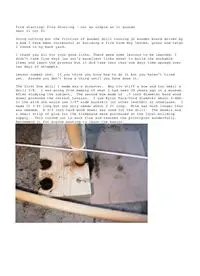
Fire Starting 2003 PDF
Preview Fire Starting 2003
Fire starting: Fire Starting - not as simple as it sounds Sent 21 Oct 01 Using nothing but the friction of wooden drill turning on wooden board driven by a bow I have been successful at building a fire from dry leaves, grass and twigs I found in my back yard. I thank you all for your good links. There were some lesions to be learned. I didn't take five days (as sol's excellent links show) to build the workable items and learn the process but it did take less than one days time spread over two days of attempts. Lesson number one: If you think you know how to do it but you haven't tried yet. Assume you don't know a thing until you have done it. The first bow drill I made was a disaster. Way too stiff a bow and too small a drill 3/8. I was going from memory of what I had seen 30 years ago in a museum. After studying the subject. The second bow made of .5 inch diameter hard wood dowel produced the correct tension. I use Nylon Para-Cord diameter about 3-4mm. In the wild one would use 1/4" wide buckskin (or other leather) or shoelaces. I made it 3 ft long but one only needs about 2 ft long. Mine was much longer than was needed. A 3/4 inch hard wood dowel was used for the drill. The dowels and a small strip of pine for the fireboard were purchased at the local building supply. This turned out to work fine and teaches the principles wonderfully. Recommend it for anyone wanting to learn the basics. Lesson number two: Don't forget the all-important Notch. This was my first big mistake. You can make smoke all day and no file with a dill tuning on wood to produce friction. As soon as you add a sloped notch (notch about half the width of the stick) from the center of the hole to ground at the outer edge of the board then things begin to work right. See the pictures above. The notch allows the carbon and dry wood dust to be pushed down to a pile at the bottom of the notch. After a couple of minutes this pile is ignited with a bit more pressure and vigorous turning. Once ignited it would smoke as "a coal" on it's own for a minute or two once the bow drilling stops. Once the drilling stops, this coal is then transferred quickly to a hand made nest of dried grass and shredded kindling or other easily burnable material. One then begins to alternately weak then blow strong and not at all until it burst into flames. It helps to stop blowing occasionally to let the heat build up. Lesson number three: Changing a burning coal into a flame can be tricky. I had about 4 failures before I went and tested what would burn and what was not as dry as I thought. After all it hasn't rained where I live for months. I thought what was brown was dry. Wrong. I ended up making what looked like a birds nest of small leaves and dried grass and small twigs. I put the hot coal in the center and closed it up a bit. Holding it in my hands. I would blow gently at first then stop and then stronger. You want the heat to build up and cause the vapors that come from the hot grass to ignite as soon as you stop blowing. Be prepared that as soon as it ignites to immediately put this burning nest some place it ketch more of the same on file in an ever-increasing gradient. Don't sit there and admire your success like I did. It will only burn for a short time. Lesson number four: Don't underestimate the amount and gradient of dry burnable substance to make fire from a glowing coal and keep it going. It is easily to under estimate what will burn and what won't easily burn. It is also easy to underestimate how short a time it takes for kindling to burn and go out. One needs lot of easy burnable material in an ever-increasing gradient of thickness. It is very easy to skip a gradient and have the fire go out before lighting the next bigger item. I am convinced without dry burnable material it would be very difficult to nearly imposable to start a next fire. The next fire needs to be planed and the items dried and otherwise prepared before the current fire goes out. Materials to use are important. I am no expert on this but my thinking is to have a hard wood and a soft wood in contact with each other. Either can be the drill and the other can be the file wood base. I choose the softwood to be the fire wood base and the drill to be hardwood. I think experience and testing of local wood will give you the best easiest to use product. I will be doing this part after the PS. I realize there are easer ways to make fire. I wanted at this time to learn perhaps the hardest way. It does point out one thing. Now that I know what it takes. I won't be wasting time making something that is not likely to work. In other words one can learn how to be a careful artisan to build something that will work and do it now. If any of you have looked at some of these TV survival shows you can find some attempts at making file with bow and drill but no successes. The reason is there is something there to be learned by doing it. Have your kids learn this under you supervision in your own back yard. MikeL
